 资源简介
资源简介
秘密★启用前
试卷类型:A
杭州学军中学(集团)高2025届高考模拟测试
英语
2025年5月
注意事项:
1.答卷前,考生务必将自己的姓名、准考证号填写在答题卡上。
2.回答选择题时,选出每小题答案后,用铅笔把答题卡上对应题目的答案标号涂黑。如需改动,用橡皮擦干净后,再选涂其他答案标号。回答非选择题时,将答案写在答题卡上,写在本试卷上无效。
3.考试结束后,将本试卷和答题卡一并交回。
第一部分 听力(共两节,满分30分)
做题时,先将答案标在试卷上,录音内容结束后,你将有两分钟的时间将试卷上的答案转涂到答题卡上。
第一节(共5小题:每小题1.5分,满分7.5分)
听下面5段对话。每段对话后有一个小题,从题中所给的A、B、C三个选项中选出最佳选项。听完每段对话后,你都有10秒钟的时间来回答有关小题和阅读下一小题。每段对话仅读一遍。
1. How did Tom get to the meeting
A By underground. B. By taxi. C. By bus.
2. How much did the man pay for the camera
A. $200. B. $175. C. $150.
3. What is the man going to read next
A. The magazine. B. His own book. C. The newspapers.
4. What does the man want to do
A. Ask for a late checkout. B. Request a wake-up call. C. Return the keys.
5. What are the speakers discussing
A. Where to put the photograph. B. Whether to move the furniture. C. How to use the computer.
第二节(共15小题:每小题1.5分,满分22.5分)
听下面5段对话或独白。每段对话或独白后有几个小题,从题中所给的A、B、C三个选项中选出最佳选项。听每段对话或独白前,你将有时间阅读各个小题,每小题5秒钟;听完后,各小题将给出5秒钟的作答时间。每段对话或独白读两遍。
听第6段材料,回答第6、7题。
6. What does the woman grow in her garden
A. Fruit trees. B. Flowers. C. Vegetables.
7. What is the most important for beginners
A. Selecting a sunny place. B. Watering plants regularly. C. Controlling harmful insects.
听第7段材料,回答第8至10题。
8. How did the woman know the new film
A. From a cinema. B. From the Internet. C. From the man.
9. Who is Jerry Peterson
A. A director. B. An actor. C. A critic.
10. When do the speakers plan to mucet
A. At 6p.m. B. At 7p.m. C. At 8p.m.
听第8段材料,回答第11至13题。
11. Where are the speakers
A. At a recycling center. B. In an office. C. At home.
12. What waste will the man take care of
A. Cans. B. Paper. C. Plastic bottles.
13. What do the speakers decide to do
A. Throw away the waste.
B. Prepare boxes for different waste.
C. Reduce the use of paper, plastic and cans.
听第9段材料,回答第14至16题。
14. What does Dorothy suggest the man do
A. Buy things online.
B. Celebrate Christmas together.
C. Go to the shopping center as soon as possible.
15. What is the man’s wife fond of
A. Reading novels. B. Going shopping. C. Watching romantic movies.
16. What will the man probably do
A. Buy a new computer. B. Ask his wife for a present. C. Let his wife tell him what to buy.
听第10段材料,回答第17至20题。
17. What was the children’s favorite future job in the study
A. An engineer. B. A doctor. C. An inventor.
18. What percentage of children showed a preference for their parents’ jobs
A. 66%. B. 50%. C. 14%
19. What amazed the researchers
A. Many girls would like to work as a doctor.
B. Many children clanged their mind growing up.
C. Many children knew nothing about their parents’ jobs.
20. What did the study in the U. S. A. show
A. What people desire to do as a career.
B. How many people realized their childhood dreams.
C. Why people didn’t follow in their parents’ footsteps.
第二部分 阅读理解(共两节,满分50分)
第一节(共15小题;每小题2.5分,满分37.5分)
阅读下列短文,从每题所给的A、B、C和D四个选项中,选出最佳答案。
A
This free summer program offers local youth aged 13 — 17 training in ocean awareness, beach safety, and basic lifeguarding skills Participants will learn ocean swimming, first aid, and rescue skills from National Park Service (NPS) lifeguards and interact with emergency services personnel.
Upon completing the program, participants will be able to identify and escape rip currents, perform basic ocean rescues, respond to medical emergencies, and gain in-depth knowledge of the coastal Marin area.
APPLICATION & TRYOUTS
The application process opens on April 7, 2025 New applicants will be contacted for an in-person interview at the Stinson Beach lifeguard tower. Returning applicants may choose a phone interview. After all interviews, 25 junior lifeguards will be selected for the program.
All junior lifeguards must pass a physical fitness screening on June 24th, consisting of a 600-yard ocean swim followed immediately by a one-mile beach run Attendance to the tryout is compulsory.
Participants aged 15 or above will be enrolled in a free American Red Cross lifeguard training program. To meet certification requirements, some coursework will be completed online outside of class hours Participants must turn 15 before finishing the program.
IMPORTANT DATES & CLASS TIMES
Application Period: April 7th — June 1st
Tryouts and Orientation: Tuesday June 24th 10:00 a.m. — 1:00 p.m.
Class Dates: Mondays and Tuesdays June 30th — August 5th
Ages 13 — 14 Class Times: 10:00 a.m. — 1:30 p.m.
Ages 15 — 17 Class Times: 10:00 a.m. — 3:00 p.m.
1 What is the main purpose of the passage
A. To promote beach safety awareness. B. To introduce a lifeguard training program.
C. To explain how to stay safe in the ocean. D. To describe the duties of junior lifeguards.
2. What must all participants do for selection
A. Join an in-person interview. B. Submit a lifeguard certificate.
C. Attend the physical fitness tryout. D. Take an online lifeguard course.
3. When will 16-year-olds have classes in the program
A. 10:00 a.m. — 1:30 p.m., every Tuesday.
B. 10:00 a.m. — 3:00 p.m., every Thursday.
C. 10:00 a.m. — 1:30 p.m., Mondays and Tuesdays.
D. 10:00 a.m. — 3:00 p.m., Mondays and Tuesdays.
B
In 1999, a teacher at Uniontown High School in Kansas, Norm Conard, encouraged four student — Elizabeth Cambers, Megan Stewart, Janice Underwood, and Sabrina Coons — to enter a national History Day contest. He told them to base their project on the Holocaust (大屠杀), reflecting the classroom motto: “He who changes one person, changes the world entire.”
Conard showed them a 1994 news clipping about “other Schindlers” — people who had saved Jews during World War II. One name stood out: Irena Sendler, a Polish woman said to have rescued 2,500 children from the Warsaw ghetto (犹太人居住区). “We thought this had to be a mistake,” said Conard. “I mean, nobody had ever heard of her.” They decided to look into the history, and soon found out the number was correct — and the story, extraordinary.
Sendler was a social worker in Warsaw. Starting in 1942, she faked a pass to enter the ghetto, where 400,000 Jews were imprisoned. Each day, she would ask parents to do the unthinkable: give their children to her so she could take them out — often hidden in sacks or toolboxes — passing through Nazi guards by claiming the children were either dead or sick. She provided the children with false papers; arranging for Polish families to adopt them or placing them in orphanages (孤儿院). Knowing they were losing their identities, Sendler made coded lists of each child’ s real and new name, buried in jars beneath an apple tree, hoping one day to reunite families.
In 1943, Sendler was arrested. She was cruelly tortured but refused to reveal anything. After three months in prison, she was sentenced to death.
The girls turned her story into a play, Life in a Jar, which moved local audiences and won first prize in Kansas’s National History Day contest. Later, they discovered Sendler was alive. In 2001, they traveled to Poland and met her. “We told her she’ s our hero,” said Elizabeth, but she said, “Heroes do extraordinary things — I just did what I had to do.”
The play has spread across the world and still continues today, keeping Sendler’s legacy alive, forever.
4. Norm Conard and his students initially thought of Sendler’s story as _________.
A. a confirmed fact B. a misleading belief
C. an inaccurate report D. a heartbreaking history
5. How did Irena Sendler manage ta rescue the children
A. By coding names and burying them in jars.
B. By hiding children and persuading the guards.
C. By falsifying identities and reuniting families.
D. By convincing parents and transferring children.
6. Which of the following best describes Irena Sendler
A. Curious and modest. B. Ambitious and sensible.
C. Courageous and selfless. D. Determined and disciplined.
7. What can be a suitable title for the text
A. Life in a Jar: A Play that Revived History B. Sendler’s Legacy: A Story Brought to light
C. The Warsaw Ghetto: A Secret Rescue Mission D. The Forgotten Hero: Sendler’s Personal Adventure
C
In satellite images of the Earth from space, the United States seems to split in half: the eastern side is much brighter than the west. Across the Atlantic, Europe glints. The Nile Delta in Africa glows like a diamond. Farther east, Hong Kong and Shanghai are afire. Developed society, it’s clear, is where the light is.
A growing field of research suggests that night-time light itself is far more dangerous than the dark. Everything that lives on this planet evolved during billions of years along a reliable cycle of day and night. But artificial light breaks the cycle. This causes sleeplessness among astronauts who take pills but still get only six hours of shuteye. Shift workers, who rise with the night and work in blue light, experience not only disturbed circadian rhythms (昼夜节律), but an increased likelihood of breast cancer.
When we, in the industrialized world, do manage to turn off the lights, there are measurable, beneficial effects. In a widely reported paper last summer, Kenneth Wright at the University of Colorado took eight students camping in the Rocky Mountains for two weeks. They weren’t allowed to use any artificial light after sunset — only the glow of campfire. After a week, melatonin (褪黑素) started to rise at sunset, peak at midnight, and decrease just at sunrise. “Internal biological time under natural light-dark conditions tightly synchronizes with environmental time,” he said.
For those of us addicted to our glowing phones and tablets, an app called Flux can help. It ‘warms’ your device’s display screen so that it shifts red in the evening, more closely matching the color of the setting sun. Just a brief glimpse at your mobile phone at bedtime is enough to expose your eyes to artificial light, so fighting such a disturbance might be an exercise in vain. But even if we can’t completely contain our thirst for light, we can all make one small gesture, which could stimulate us to unplug a little more.
8. What can we infer from paragraph 2
A. Darkness poses health threats to shift workers.
B. Sleeplessness are more likely to cause breast cancer.
C. Humans can easily adapt to the changing surroundings.
D. Astronauts take pills to minimize day-and-night cycle disturbance.
9. What does the underlined word “synchronize with” in paragraph 3 mean
A. Correspond to. B. Interact with
C. Object to. D. Blend with.
10. How does Flux help reduce the harmful effects of artificial light
A. By blocking artificial lights. B. By warming the screen temperature.
C. By reducing screen brightness. D. By creating the natural change of light.
11. What’s the purpose of the final sentence
A. To settle a debate. B. To suggest a solution.
C. To promote a product. D. To contradict an assumption.
D
Long before Webster completed his 1828 masterpiece, An American Dictionary of the English Language, he published A Grammatical Institute of the English Language, which matched traditional English orthography (拼写法), with, for instance, entries for “theatre” and “publick”. After that, however, Webster became committed to an American dialect that would be distinct from British English. He featured updated spellings of a number of words, including “theater” and “public”.
As Gab e Henry notes in Enough Is Enuf, a history of the largely fruitless efforts to reform English spelling, Webster wasn’t motivated by nationalism alone. He had also become an advocate of comprehensive changes to written English, mourning its “irregular” orthography. Mr. Henry begins his smart, lighthearted account of the simplified spelling movement by identifying the “heart of our problem” that “English has 44 sounds but only 26letters” and that each sound has, “on average, four ways of spelling it”. Over the centuries, reformers have proposed solutions—including adding new letters to the alphabet and removing existing letters from the alphabet—all in vain.
It’s fitting that Henry, our guide through this history, is a humorist. For one thing, simplified spelling looks funny, a fact that 19th-century writers such as Josh Billings, skillfully employed. “I owe my suksess in life to midevoshun to spelyng,” Billings once wrote. Enough Is Enuf also finds humor in how deadly serious some notable figures were about spelling reform, Melvil Dewey, the creator of the Dewey System, was born “Melville,” but his commitment to spelling reform started with his own name.
The final section of Enough Is Enuf brings simplified spelling into the current age, covering advertising, digital technology and even the pop songwriting of Prince. Of course, texting and social media have simplified the way we communicate, satisfying the remaining die-hare spelling reformers even as traditionalists mourn the rise of “GR8,” “pls,” and the like. Mr. Henry, for his part, is untroubled by text-speak, and he argues that Webster would be too, who once wisely noted “It is quite impossible to stop the progress or language.”
12. Why is Webster mentioned at the beginning
A. To honor his contribution to American English.
B To compare his works with those of other writers.
C. To show his nationalist views on English spelling.
D. To provide a historical context for spelling reform.
13. Which of the following shows the reformers’ efforts
A. Webster updated “theater” to “theatre”. B. Melville changed the spelling of his name.
C. Four ways of spelling a sound were invented. D. Words like “Gr8” and “pls” are widely used.
14. What is Henry’s attitude towards the spelling reform
A. Objective. B. Subjective.
C. Critical. D. Dismissive.
15. Where is this text most likely from
A. A book review. B. A history text.
C. A cultural magazine. D. A research report.
第二节(共5小题;每小题2.5分,满分12.5分)
根据短文内容,从短文后的选项中选出能填入空白处的最佳选项。选项中有两项为多余选项。
How To Be a Bolder, More Confident Person
Want to boost your self-confidence, feel more empowered, and take charge of your life ___16___ By embracing a bold mindset, you will unlock greater confidence, resilience, and control over your life. Here are some valuable tips to help you discover your passions and strengths, while overcoming your fears.
Stop hesitating and take action to build your self-confidence.
Is there something you’ve been wanting or trying to do, but can’t seem to get the courage up ___17___. Taking the first small step towards trying something new can give you the energy to keep going. Whenever you’ re feeling unsure in interactions with others, swallow your pride and make the first move!
Do the unexpected and get out of your comfort zone.
Doing something new and unexpected might make you feel uneasy or afraid. ___18___. Instead, embrace the newness of a skill, trust your ability to adapt and don’t be afraid to be yourself. Remember, taking a risk like learning a new skill isn’t the same as making impulsive (冲动的) decisions. To avoid regrets, make choices and take actions reflecting your values.
Pretend you’ re already bold.
Your bold inspiration doesn’t have to be real. You could even think of a character from a movie or book who’s daring and brave. Then, imagine their boldness in your life. If you already know someone bold, imagine how they’d act. Studies show your mood can be affected by your behavior. ___19___
___20___
While there’s power in taking on something new or trying to get what you want, there’s also the chance you may fail. Embrace the failure. It’s not the opposite of success, it’s a necessary component. Without the risk of failure, you don’t have the opportunity for success.
Being bold lets you oxford, embrace, and take charge of your life.
A. Accept any outcome.
B. Don’t give in to those feelings!
C. Take small steps to reach your goals.
D. Stop thinking and actually do something.
E. “Fake it until you make it” has some truth to it!
F. Part of being bold involves staying calm and focused.
G. Developing a bold personality is a skill you can practice.
第三部分 语言知识运用(共两节,满分30分)
第一节(共15小题;每小题1分,满分15分)
阅读下面短文,从短文后各题所给的A、B、C和D四个选项中,选出可以填入空白处的最佳选项。
We lived in Cleveland, Ohio. One afternoon a couple of summers ago, just as the sky was ____21____, a woman I didn’t know stood ____22____ in our doorway, holding the screen door open. I saw the silhouette (轮廓) of her head through the window. She didn’t feel well at all. So, I wondered, what should I do now
This moment of decision had ____23____ me before. For nineteen years, we’ve lived at the ____24____ of a highway, which often leads exhausted cars to our house. These travelers have all asked for little things, such as the phone, a glass of water, or ____25____ directions. All have been strangers to me.
Nowadays, we live in a world full of suspicion. Conventional wisdom advises that to ____26____ a good person is to be naive and risk terrible consequences. News is full of stories about ____27____ who unintentionally endanger themselves. There is no doubt that those are true stories, but the lesson goes against my belief. Sometimes to do the right thing, you must ____28____. Must we fear all of those whom we don’t know Is our own personal safety always the important ____29____
Our location ____30____ me to make difficult choices. The highway makes it impossible to ____31____ the world and relationship to it. When someone approaches us for help, I have to decide: Do I help them or not
I believe ____32____ others who need help endangers me, too. I’d rather risk my ____33____ safety than my peace of mind. I’d rather live my life acting out of ____34____ than save it by living in uneasiness.
So when the woman was sinking like the sun on my front doorstep, I made my choice.
I ____35____ the door.
21. A. clearing B. brightening C. darkening D. clouding
22. A. sinking B. drooping C. weeping D. shouting
23. A. led to B. responded to C. appealed to D. happened to
24 A. exit B. heart C. entrance D. peak
25. A. even B. merely C. mainly D. randomly
26. A. work as B. learn from C. act as D. hear from
27. A. explorers B. survivors C. victims D. adventurers
28. A. take action B. take responsibility C. take notes D. take risks
29. A. advice B. consideration C. ideas D. criterion
30. A. forces B. allows C. motivates D. begs
31. A. ignore B. greet C. notice D. fight
32. A. accepting B. rejecting C. embracing D. disliking
33. A. virtual B. emotional C. physical D. spiritual
34. A. necessity B. envy C. curiosity D. mercy
35. A. opened B. locked C. closed D. pushed
第二节(共10小题;每小题1.5分,满分15分)
阅读下面短文,在空白处填入1个适当的单词或括号内单词的正确形式。
Thousands of self-named “TikTok refugees (难民)” are flooding to Xiaohongshu (also known as RedNote in App Store), ____36____ Chinese social media platform. The US Supreme Court is expected to decide ____37____ TikTok can continue operating in the country before the January 19 deadline. As it faces a such potential ban in the United States, it is sent to the top of the US App Store download chart. By the end of last week, Xiaohongshu ____38____ (download) the most, ranking the top on Apple’s US App Store. Originally launched in 2013 ____39____ a lifestyle platform, Xiaohongshu boasts over 300 million ____40____ (month) active users and exceeded US$1 billion in profit in 2024, according to Bloomberg.
Some Chinese users are going to the extra miles ____41____ (guide) international newcomers. A user named Eddy Liu created a group chat offering in-depth analyses on mastering Xiaohongshu, while others have posted ____42____ (instruction) to make the Chinese-dominated app more accessible. Miss Fifty Yuan, a graduate from Fudan University, ____43____ (author) a beginner’s guide to Chinese Internet slang previously, translating terms like yyds (GOAT), which was widely popular. Chinese and US users are ____44____ (enthusiastic) sharing photos of their pets, particularly cats, as they make their first interactions on Xiaohongshu. US users have humorously nicknamed these images as the “Cat Tax”, ____45____ (refer) to a playful exchange for engagement with Chinese users.
第四部分 写作(共两节,满分40分)
第一节(满分15分)
46. 假定你是李华,近期你的英国好友Brian给你分享了他所编写的《校园急救手册》 (Campus First Aid Guide) 并向你寻求反馈,请你写一封回信,内容包括:
1.阅读感受;
2.改进建议。
注意:
(1)写作词数应为80左右;
(2)请按如下格式在答题卡的相应位置作答。
Dear Brian,
__________________________________________________________________________________________________________________________________________________________________________________________________________________________________________________________________________________________________________________________________________________________________________________________________________________________________________________________________
Yours,
Li Hua
第二节(满分25分)
47. 阅读下面材料,根据其内容和所给段落开头语续写两段,使之构成一篇完整的短文。
I headed to the library for my favorite after-school activity: Writing Club. Today, Miss Lisa, our writing club leader, was going to ask us to share our competition entries with a critique partner. A critique means giving helpful feedback so someone can tell their best story.
My critique partner was Penny. When I handed my story to her, I was nervous. I had no problem coming up with great story ideas, but I did have problems with spelling. And grammar. And punctuation. By contrast, Penny always got perfect scores on these.
Penny didn’t look at me as she pushed her story toward me. I read it without stopping. Why did she seem worried about such an incredible story It was about a dog named Sunny who saved a family from a flooding river on a stormy night. “I don’t have any suggestions. It’s perfect! You’ll definitely win a prize in the competition!” I told her. “Yours too, Aidan,” she mumbled, passing mine back without a smile.
When Miss Lisa called it a day, Penny looked relieved. She jumped up, grabbed her backpack, and everything fell out. She quickly shoved her stuff back in and hurried out of the library. I noticed a book under the table. It must have fallen out of Penny’s bag. I flipped through the book, titled Sunny the Brave. It was just like Penny’s story! I couldn’t believe it—Penny had copied the idea!
I felt angry for a moment, but soon I calmed down. I remembered that my job as her critique partner was to give helpful feedback, not to make her feel bad. But what should I say to her I kept thinking about Penny and her story as I walked home. When I got back, Mom was in the kitchen making dinner with Dad. Dad was chopping vegetables into perfect shapes, and Mom was stirring a sauce on the stove. I realized that Mom and Dad had different skills, which made them a great creative team. With Dad’s attention to detail and Mom’s sense of adventure, their dinners always turned out delicious.
注意:
(1)续写词数应为150左右;
(2)请按如下格式在答题卡的相应位置作答。
Paragraph 1: At school the next morning, I held out the book to Penny, saying “You dropped this.”
__________________________________________________________________________________________________________________________________________________________________________________________________________________________________________________________________________________________________________________________________________________________________________________________________________________________________________________________________
Paragraph 2: Suddenly, I thought of how my parents cooked together and an idea popped into my mind.
__________________________________________________________________________________________________________________________________________________________________________________________________________________________________________________________________________________________________________________________________________________________________________________________________________________________________________________________________
秘密★启用前
试卷类型:A
杭州学军中学(集团)高2025届高考模拟测试
英语
2025年5月
注意事项:
1.答卷前,考生务必将自己的姓名、准考证号填写在答题卡上。
2.回答选择题时,选出每小题答案后,用铅笔把答题卡上对应题目的答案标号涂黑。如需改动,用橡皮擦干净后,再选涂其他答案标号。回答非选择题时,将答案写在答题卡上,写在本试卷上无效。
3.考试结束后,将本试卷和答题卡一并交回。
第一部分 听力(共两节,满分30分)
做题时,先将答案标在试卷上,录音内容结束后,你将有两分钟的时间将试卷上的答案转涂到答题卡上。
第一节(共5小题:每小题1.5分,满分7.5分)
听下面5段对话。每段对话后有一个小题,从题中所给的A、B、C三个选项中选出最佳选项。听完每段对话后,你都有10秒钟的时间来回答有关小题和阅读下一小题。每段对话仅读一遍。
1. How did Tom get to the meeting
A. By underground. B. By taxi. C. By bus.
2. How much did the man pay for the camera
A. $200. B. $175. C. $150.
3. What is the man going to read next
A. The magazine. B. His own book. C. The newspapers.
4. What does the man want to do
A. Ask for a late checkout. B. Request a wake-up call. C. Return the keys.
5. What are the speakers discussing
A. Where to put the photograph. B. Whether to move the furniture. C. How to use the computer.
第二节(共15小题:每小题1.5分,满分22.5分)
听下面5段对话或独白。每段对话或独白后有几个小题,从题中所给的A、B、C三个选项中选出最佳选项。听每段对话或独白前,你将有时间阅读各个小题,每小题5秒钟;听完后,各小题将给出5秒钟的作答时间。每段对话或独白读两遍。
听第6段材料,回答第6、7题。
6. What does the woman grow in her garden
A. Fruit trees. B. Flowers. C. Vegetables.
7. What is the most important for beginners
A. Selecting a sunny place. B. Watering plants regularly. C. Controlling harmful insects.
听第7段材料,回答第8至10题。
8. How did the woman know the new film
A. From a cinema. B. From the Internet. C. From the man.
9. Who is Jerry Peterson
A. A director. B. An actor. C. A critic.
10. When do the speakers plan to mucet
A. At 6p.m. B. At 7p.m. C. At 8p.m.
听第8段材料,回答第11至13题。
11. Where are the speakers
A. At a recycling center. B. In an office. C. At home.
12 What waste will the man take care of
A. Cans. B. Paper. C. Plastic bottles.
13. What do the speakers decide to do
A. Throw away the waste.
B. Prepare boxes for different waste.
C. Reduce the use of paper, plastic and cans.
听第9段材料,回答第14至16题。
14. What does Dorothy suggest the man do
A. Buy things online.
B. Celebrate Christmas together.
C. Go to the shopping center as soon as possible.
15. What is the man’s wife fond of
A. Reading novels. B. Going shopping. C. Watching romantic movies.
16. What will the man probably do
A. Buy a new computer. B. Ask his wife for a present. C. Let his wife tell him what to buy.
听第10段材料,回答第17至20题。
17. What was the children’s favorite future job in the study
A. An engineer. B. A doctor. C. An inventor.
18. What percentage of children showed a preference for their parents’ jobs
A. 66%. B. 50%. C. 14%
19. What amazed the researchers
A. Many girls would like to work as a doctor.
B. Many children clanged their mind growing up.
C. Many children knew nothing about their parents’ jobs.
20. What did the study in the U. S. A. show
A. What people desire to do as a career.
B. How many people realized their childhood dreams.
C. Why people didn’t follow in their parents’ footsteps.
第二部分 阅读理解(共两节,满分50分)
第一节(共15小题;每小题2.5分,满分37.5分)
阅读下列短文,从每题所给的A、B、C和D四个选项中,选出最佳答案。
A
【1~3题答案】
【答案】1. B 2. C 3. D
B
【4~7题答案】
【答案】4. C 5. D 6. C 7. B
C
【8~11题答案】
【答案】8. D 9. A 10. D 11. B
D
【12~15题答案】
【答案】12. D 13. B 14. A 15. A
第二节(共5小题;每小题2.5分,满分12.5分)
根据短文内容,从短文后的选项中选出能填入空白处的最佳选项。选项中有两项为多余选项。
【16~20题答案】
【答案】16. G 17. D 18. B 19. E 20. A
第三部分 语言知识运用(共两节,满分30分)
第一节(共15小题;每小题1分,满分15分)
阅读下面短文,从短文后各题所给的A、B、C和D四个选项中,选出可以填入空白处的最佳选项。
【21~35题答案】
【答案】21. C 22. B 23. D 24. A 25. B 26. C 27. C 28. D 29. B 30. A 31. A 32. B 33. C 34. D 35. A
第二节(共10小题;每小题1.5分,满分15分)
【36~45题答案】
【答案】36. a 37. whether##if
38. had been downloaded
39. as 40. monthly
41. to guide
42. instructions
43. authored
44. enthusiastically
45. referring
第四部分 写作(共两节,满分40分)
第一节(满分15分)
【46题答案】
【答案】Dear Brian,
Thank you for sharing your Campus First Aid Guide! I’m truly impressed by it, which covers essential skills clearly. The illustrations are helpful, especially when they show how to handle bleeding.
However, I have two suggestions to improve it. First, since many students may be unfamiliar with professional terms, could you add a section that explains them in simple language at the end Second, it would be better if you could put in some pictures that show proper first aid positions.
Overall, Your work is valuable, and I believe it will benefit many students.
Yours,
Li Hua
第二节(满分25分)
【47题答案】
【答案】
At school the next morning, I held out the book to Penny, saying “You dropped this.” Her face reddened as she quietly explained that she had borrowed it for inspiration. “I thought my ideas were dull, and grammar’s my only strength,” she said. I smiled, “Your grammar is amazing, and your Sunny story is full of emotion! Although I’m not good at spelling or grammar, I love creating stories. Both of us are remarkable.”
Suddenly, I thought of how my parents cooked together and an idea popped into my mind. I suggested, “Let’s be a team — you fix my grammar, and I’ll flesh out your plot. As my parents do, we can mix your precision with my creativity.” Penny’s eyes brightened. She looked up, surprised, and agreed. “But why forgive me for copying ” she asked. “Friends grow together,” I said. We opened our notebooks, using the book as a spark to rewrite her story. When we work as a team, inspiration grows into something we create together.
展开更多......
收起↑
 资源预览
资源预览
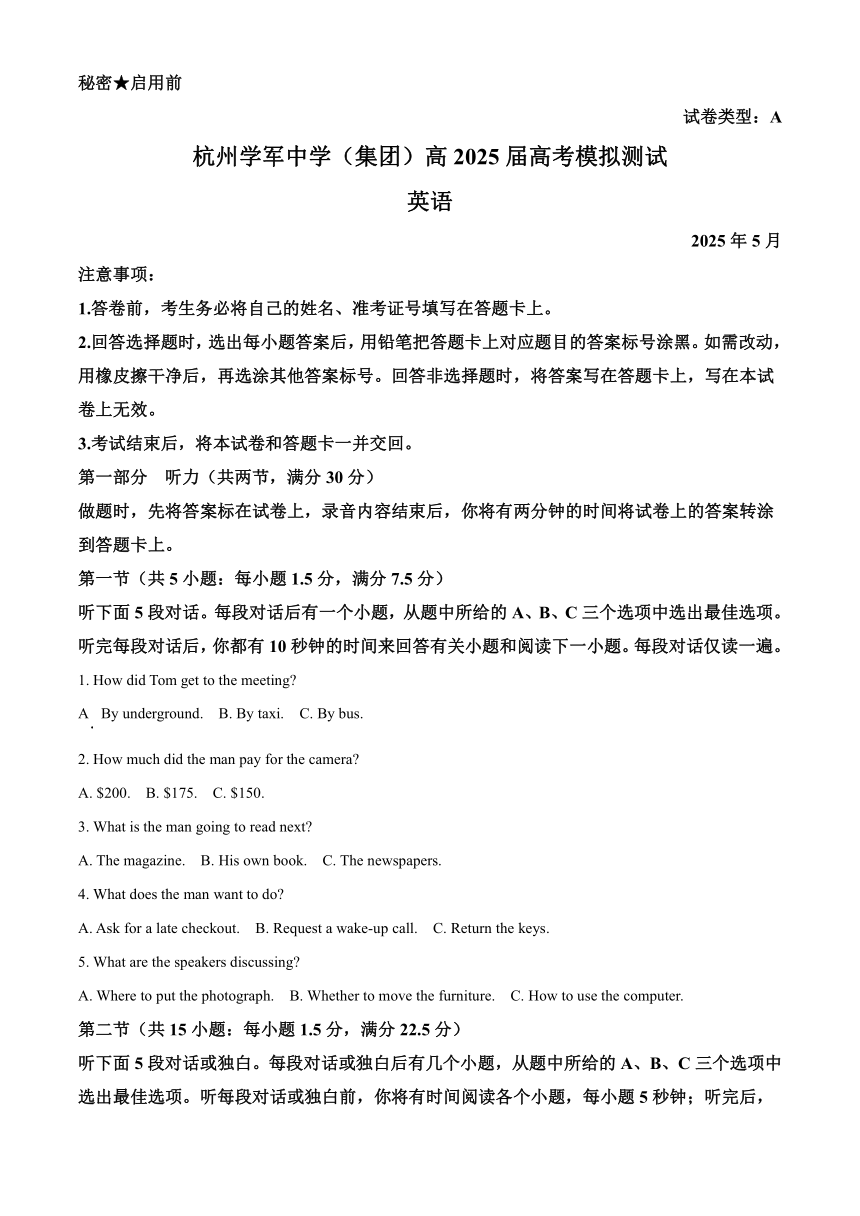
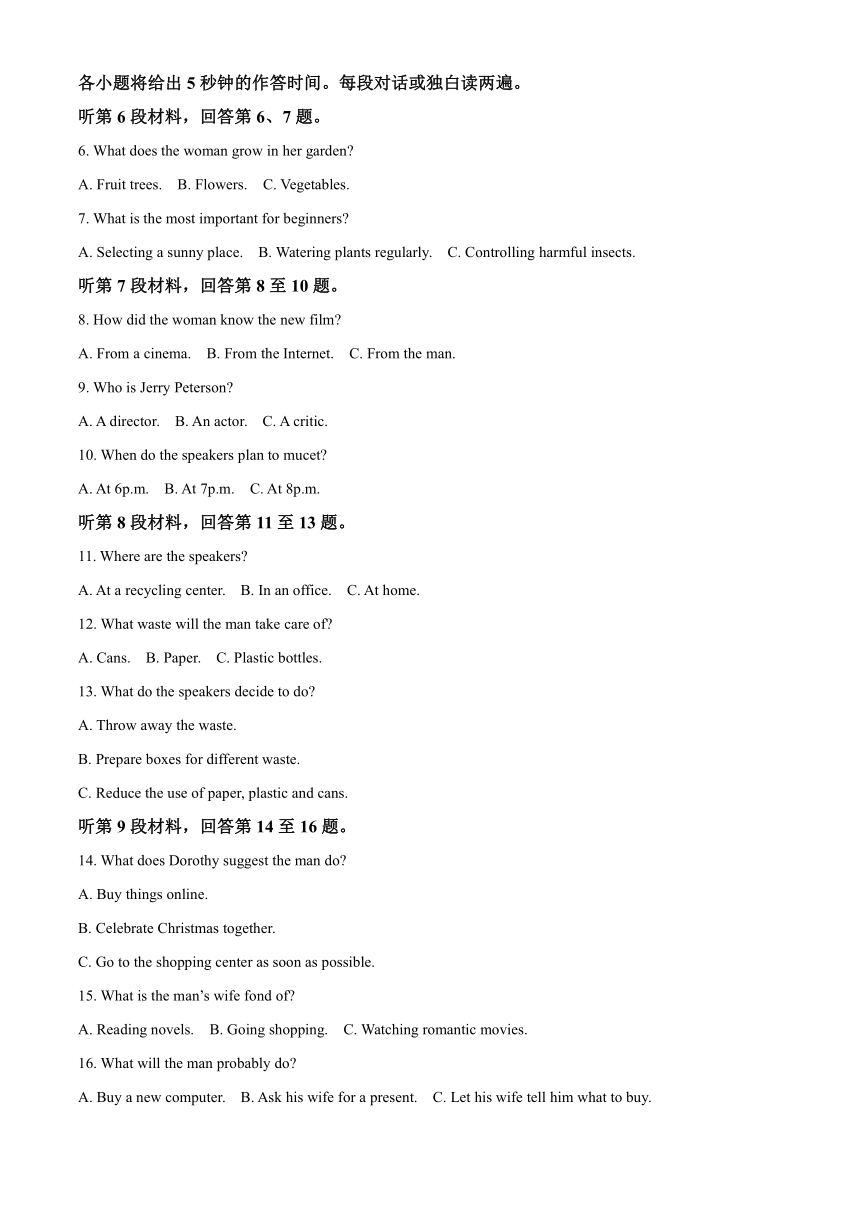
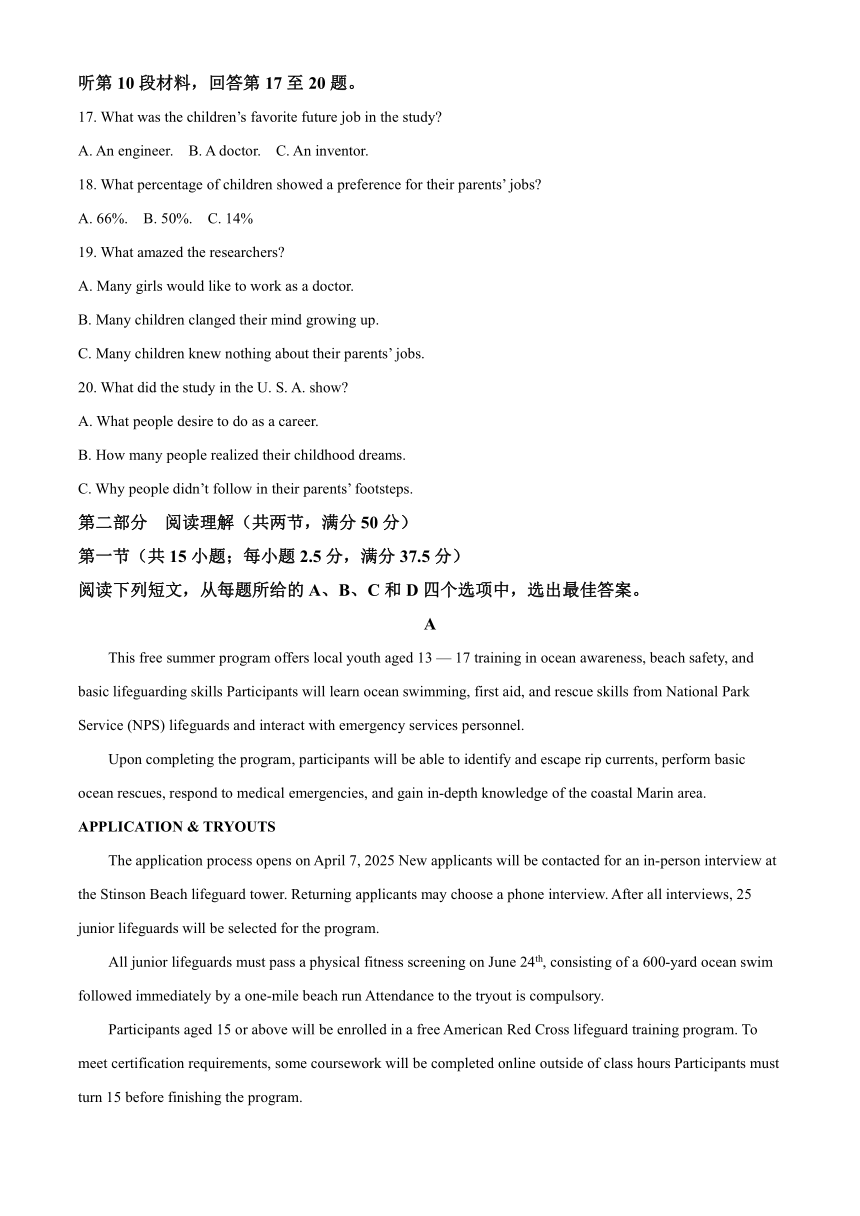
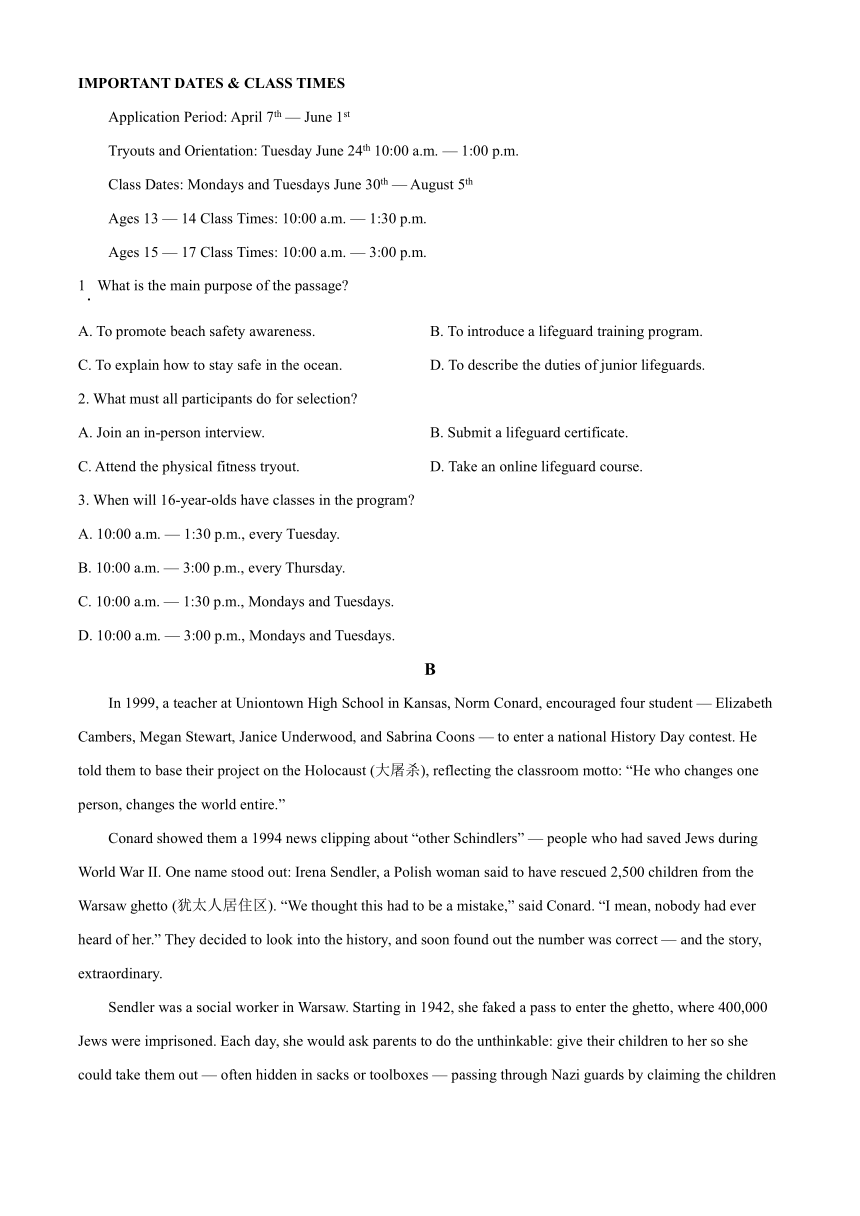
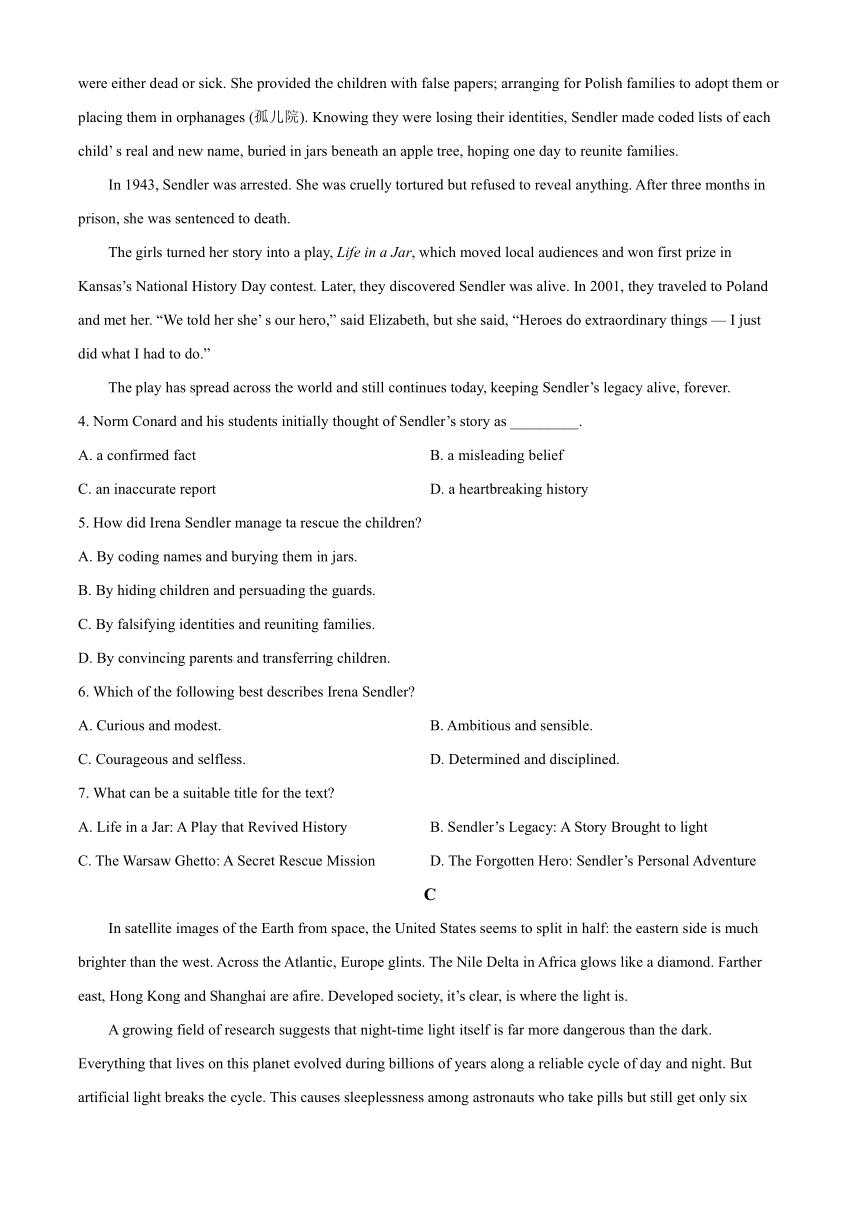
 资源预览
资源预览




